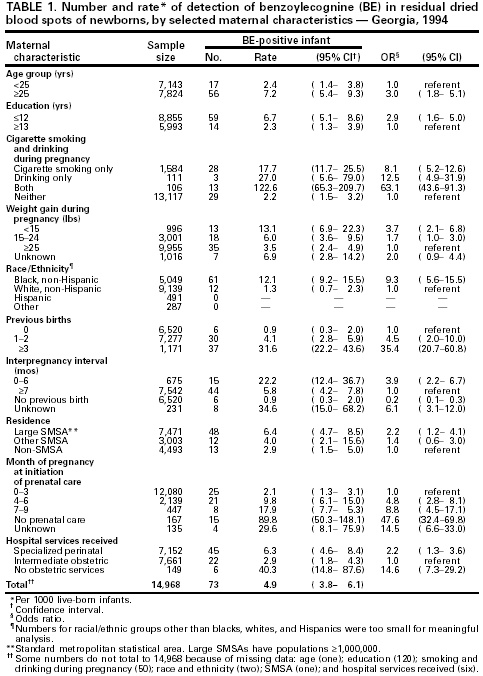Population-Based Prevalence of Perinatal Exposure to Cocaine -- Georgia, 1994
Download PDF Version What is PDF?
Reported by: M Brantley, MPH, R Rochat, MD, Office of Perinatal Epidemiology, Epidemiology and Prevention Br; V Floyd, MD, D Norris, Family Health Br; E Franko, DrPH, Public Health Laboratory; P Blake, MD, Epidemiology Section, K Toomey, MD, State Epidemiologist, Div of Public Health, Georgia Dept of Human Resources. P Fernhoff, MD, B Ziegler, L Mayer, Georgia Chapter, March of Dimes Birth Defects Foundation, Atlanta. Clinical Biochemistry Br, Div of Environmental Health Laboratory Sciences, Birth Defects and Genetic Diseases Br, and Div of Birth Defects and Developmental Disabilities, National Center for Environmental Health; Pregnancy and Infant Health Br, Div of Reproductive Health, National Center for Chronic Disease Prevention and Health Promotion, CDC.
Source:
Centers for Disease Control and Prevention, Population-Based
Prevalence of Perinatal Exposure to Cocaine -- Georgia,
1994 , MMWR, 45(41);887-891, October 18, 1996
Public Domain
Table of Contents (TOC)
Article: Population-Based Prevalence of Perinatal Exposure to Cocaine -- Georgia, 1994Editorial Note
Tables
References
Maternal cocaine use during pregnancy is associated with adverse health effects for both the mother and the infant (e.g., intrauterine growth retardation, placental abruption, preterm delivery, congenital anomalies, and cerebral injury).1 Because cocaine use often occurs concurrently with use of other substances (e.g., cigarettes and alcohol) and because fear of prosecution may deter women from obtaining medical care, the occurrence of perinatal exposure to cocaine has not been well characterized. In Georgia, the routine collection of dried blood spots (DBSs) from a heel-stick of newborns for screening for metabolic diseases enabled the Georgia Chapter of the March of Dimes Birth Defects Foundation, the Georgia Department of Human Resources (DHR), and CDC to collaborate on a feasibility study of the use of residual DBSs for conducting low-cost population-based surveillance for perinatal cocaine exposure. This report presents the findings of the study, which indicate that, in 1994, at least 0.5% of infants in Georgia had had perinatal exposure to cocaine.
 The sample for this study comprised newborns whose DBS
specimens were submitted to DHR during a 2-month period
in 1994 and for whom an adequate specimen was available
after completion of metabolic screening. Because of probable
fear of prosecution and lack of informed consent, testing
for cocaine metabolite was conducted with anonymous specimens.
If more than one DBS specimen was obtained for a newborn,
only the results of the earliest specimen were included
in this analysis. Newborns with gestations less than 31
weeks or birthweights less than 1500 g (less than 3 lbs,
5 oz) were excluded from analysis because only approximately
50% of these newborns were tested within 7 days after birth
-- a maximum time period for reliable detection of cocaine
metabolite in the DBS specimen. Multiple births and all
newborns tested after 7 days of age also were excluded.
A total of 16,470 eligible infants were born during the
2-month period; of these, DBS specimens from 14,968 (91%)
newborns were submitted to DHR and tested by CDC for cocaine
metabolite.
The sample for this study comprised newborns whose DBS
specimens were submitted to DHR during a 2-month period
in 1994 and for whom an adequate specimen was available
after completion of metabolic screening. Because of probable
fear of prosecution and lack of informed consent, testing
for cocaine metabolite was conducted with anonymous specimens.
If more than one DBS specimen was obtained for a newborn,
only the results of the earliest specimen were included
in this analysis. Newborns with gestations less than 31
weeks or birthweights less than 1500 g (less than 3 lbs,
5 oz) were excluded from analysis because only approximately
50% of these newborns were tested within 7 days after birth
-- a maximum time period for reliable detection of cocaine
metabolite in the DBS specimen. Multiple births and all
newborns tested after 7 days of age also were excluded.
A total of 16,470 eligible infants were born during the
2-month period; of these, DBS specimens from 14,968 (91%)
newborns were submitted to DHR and tested by CDC for cocaine
metabolite.
Data about maternal characteristics were collected from the birth certificate. For each specimen, a 1/4-punch (equivalent to a 12-uL blood specimen) was obtained from one blood spot and was tested for benzoylecognine (BE) -- a primary cocaine metabolite using a modified radioimmunoassay (RIA).2 Samples with BE measured at greater than 0 ng/mL by RIA were then tested by liquid chromatography/tandem mass spectrometry for confirmation of BE at CDC.3
Rigorous measures were employed to ensure anonymity of the final analysis database. In particular, personal identifying information and laboratory results were not present in the database simultaneously, and the analysis files precluded combination of attributes that potentially could permit inferential identification of any person.
Of the 14,968 newborns, specimens for 73 tested positive for BE, representing a statewide prevalence rate of 4.9 BE-positive per 1000 newborns. Maternal characteristics associated with high rates of BE in newborns included older age; education of less than 13 years; self-reported cigarette smoking, alcohol drinking, or both during pregnancy; inadequate weight gain during pregnancy; black race; having had three or more previous live-born infants; and having a short interpregnancy interval (Table 1). Rates also were higher for mothers residing in large standard metropolitan statistical areas (population greater than or equal to 1,000,000). Mothers of BE-positive newborns resided in 17 of the 19 health districts in Georgia.
The mothers of BE-positive newborns were more likely than those of BE-negative newborns to have received late or no prenatal care. However, 74% of the mothers of BE-positive newborns had received some prenatal care, and 34% had initiated prenatal care during the first trimester. Mothers of BE-positive newborns were more likely to have given birth in large hospitals with specialized perinatal services (level III) and in hospitals with no obstetric services or outside of hospitals (level 0) than in hospitals with intermediate obstetric services (levels I and II).
This study in Georgia is the first to use newborn DBSs to determine perinatal exposure to cocaine. Statewide prevalences of perinatal cocaine exposure have been estimated previously by testing maternal urine samples obtained at delivery from women in California,4 Missouri,5 Rhode Island,6 South Carolina,7 and Utah.8 In Alabama, statewide prevalence was estimated by testing maternal urine specimens at delivery from pregnant women attending public health clinics.9 Although these studies employed different methodologies, the characteristics of women in Georgia who used cocaine during pregnancy were consistent with patterns in previous reports.1, 8 In addition, in Georgia, evidence of antepartum cocaine exposure was present among newborns in areas throughout the state and in diverse population groups.
 To reduce cocaine use during pregnancy, in 1990 the Georgia General
Assembly convened a Conference on Children of Cocaine and Substance
Abuse (CCCSA), which recommended that cocaine-using pregnant women be
treated and not prosecuted. Acknowledging this recommendation, in 1992
the Georgia Court of Appeals established that mothers who prenatally
pass cocaine to their infants may not be prosecuted under Georgia law.
* In addition, CCCSA recommended the feasibility study detailed in this
report.
To reduce cocaine use during pregnancy, in 1990 the Georgia General
Assembly convened a Conference on Children of Cocaine and Substance
Abuse (CCCSA), which recommended that cocaine-using pregnant women be
treated and not prosecuted. Acknowledging this recommendation, in 1992
the Georgia Court of Appeals established that mothers who prenatally
pass cocaine to their infants may not be prosecuted under Georgia law.
* In addition, CCCSA recommended the feasibility study detailed in this
report.
The findings in this report probably underestimate the prevalence of cocaine exposure during pregnancy in Georgia for at least three reasons. First, screening of newborns provides information about cocaine exposure only near the time of delivery and not about exposures that may have occurred earlier.10 Second, DBS samples are not collected for fetal deaths and may not be collected routinely during the interval of detection of BE for early neonatal deaths and for newborns in intensive care, especially for infants with very low birthweight and infants born prematurely. Finally, because cocaine metabolite is excreted from the body, testing must occur soon after birth; in a preliminary analysis before this Georgia study, no positive test results were identified for newborns aged greater than 7 days.
Despite these limitations, this feasibility study illustrates that DBS screening can assist in estimating the population-based prevalence of perinatal cocaine exposure. As a result of technological improvements associated with this effort in Georgia, the immunoassay for BE in DBSs can now be used for screening with laboratory confirmation of positive values by liquid chromatography/tandem mass spectrometry.2 This methodology also can be used to detect other substances (e.g., tetrahydrocannabinol and nicotine) and their metabolites. When measures for ensuring anonymity are employed and legal protection against prosecution is provided, this approach can assist states or large communities in designing and evaluating population-wide prevention and intervention activities to reduce cocaine and other substance use among pregnant women. In addition, efforts are needed to increase public support for such studies and for programs to prevent cocaine use during pregnancy.

1. Holzman C, Paneth N. Maternal cocaine use during pregnancy and perinatal outcomes. Epidemiol Rev 1994;16:315-34.
2. Henderson LO, Powell MK, Hannon WH, et al. Radioimmunoassay screening of dried blood spot materials for benzoylecgonine. J Anal Toxicol 1993;17:42-7.
3. Sosnoff CS, Ann Q, Bernert JT, et al. Analysis of benzoylecgonine in dried blood spots by liquid chromatography/atmospheric pressure chemical ionization tandem mass spectrometry. J Anal Toxicol 1996;20:179-84.
4. Vega WA, Kolody B, Hwang J, Noble A. Prevalence and magnitude of perinatal substance exposures in California. N Engl J Med 1993;329:850-4.
5. Dempsey ME, Schlechte T, Stockbauer JW, Schramm WF, Cary PC. Prevalence and implications of perinatal substance use in Missouri. Missouri Medicine 1996;93:292-9.
6. Hollinshead WH, Griffin JF, Scott HD, Burke ME, Coustan DR, Vest TA. Statewide prevalence of illicit drug use by pregnant women -- Rhode Island. MMWR 1990;39:225-7.
7. Nalty D. 1991 South Carolina prevalence study of drug use among women giving birth: report of the South Carolina Commission of Alcohol and Drug Abuse. Columbia, South Carolina: South Carolina Commission on Alcohol and Drug Abuse, 1991.
8. Buchi KF, Varner MW, Chase RA. The prevalence of substance abuse among pregnant women in Utah. Obstet Gynecol 1993;81:239-42.
9. Pegues DA, Engelgau MM, Woernle CH. Prevalence of illicit drugs detected in the urine of women of childbearing age in Alabama public health clinics. Public Health Rep 1994;109:530-8.
10. Casanova OQ, Lombardero N, Behnke M, Eyler FD, Conlon M, Bertholf RL. Detection of cocaine exposure in the neonate: analyses of urine, meconium, and amniotic fluid from mothers and infants exposed to cocaine. Arch Pathol Lab Med 1994;118:988-93.


